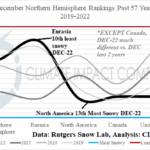
Eurasia Snow Cover 10th Least Snowy in December 2022; Last Week of December 4th Least Snowy
01/07/2023, 10:15 am ESTThe December 2022 U.S. Climate Rankings by State and the 2022 Annual State Rankings
01/10/2023, 1:15 pm ESTArgentina drought surging, Western U.S. short and long-term drought fading.

Fig. 1: December 2022 global soil moisture anomalies and 3-month trend.
Observation discussion: Large regional soil moisture changes during Q4/2022 favored wetter (12) vs. drier (8) trends (Fig. 1). The most prominent wetter change is across the Western U.S. and that wetter transition has accelerated in January. The most dramatic dry trend is across Argentina where drought intensified. Other large regional soil moisture changes of note are a vast wetter change across north and northeast South America, Portugal/Spain to U.K. plus Western/Central and Northeast Russia. Central and eastern Australia observed a wetter trend during late 2022. Interior South Africa and Northern India also received heavy rain turning soils wetter.
Notable dry soil trend other than Argentina were observed in Chile, Western Canada, Turkey, parts of tropical Africa and Madagascar.
The 3-month outlook for Q1/2023 indicates the Argentina dry risk shifts farther north into Southeast Brazil while Chilean drought also worsens (Fig. 2). Northeast Brazil stays wet. In the U.S., dryness is dominant across New Mexico/Texas and Old Mexico and vicinity for early 2023. The Interior Northwest and Ohio Valley are wet zones guided by a lingering although weakening La Nina climate. Wet climate is forecast to ease drought in Northern Russia while already wet soils of Northwest and Northeast Russia continue to trend wetter. A dry climate intensifies drought for Turkey and East China while South-central Australia gains a new dry climate pattern.

Fig. 2: December 2022 global soil moisture anomalies and 3-month forecast.
